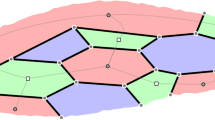A map (S,G) is a closed Riemann surface S with embedded graph G such that S \G is the disjoint union of connected components, called faces, each of which is homeomorphic to an open disk. Tutte began a systematic study of maps in the 1960s and contemporary authors are actively developing it. In the present paper, after recalling the concept of a circular map introduced by the author and Mednykh, a relationship between bipartite maps and circular maps is demonstrated via the concept of the duality of maps. In this way an enumeration formula for the number of bipartite maps with a given number of edges is obtained. A hypermap is a map whose vertices are colored black and white in such a way that every edge connects vertices of different colors. The hypermaps are also known as dessins d’enfants (or Grothendieck’s dessins).
A hypermap is self-equivalent with respect to reversing the colors of vertices if it is equivalent to the hypermap obtained by reversing the colors of its vertices.
The main result of the present paper is an enumeration formula for the number of unrooted hypermaps, regardless of genus, which have n edges and are self-equivalent with respect to reversing the colors of vertices. Bibliography: 13 titles.
Similar content being viewed by others
References
R. Cori, “Un code pour les graphes planaires et ses applications,” Thèse de Doctorat, Paris (1973).
M. A. Deryagina and A. D. Mednykh, “On the enumeration of circular maps with given number of edges,” Sib. Mat. Zh., 54, No. 4, 624–639 (2013).
A. Grothendieck, “Esquisse d’un programme,” in: Geometric Galois Action, Cambridge Univ. Press (1997), pp. 5–48.
M. Hall Jr., “Subgroups of finite index in free groups,” Canad. J. Math., 1, 187–190 (1949).
D. M. Jackson and T. I. Visentin, An Atlas of the Smaller Maps in Orientable and Nonorientable Surfaces, Chapman and Hall, Boca Raton (2001).
S. K. Lando and A. K. Zvonkin, Graphs on Surfaces and Their Applications, Springer-Verlag (2004).
V. A. Liskovets, “On the enumeration of subgroups of a free group,” Dokl. Akad. Nauk BSSR, 15, No. 1, 6–9 (1971).
V. A. Liskovets, “Enumerative formulae for unrooted planar maps: a pattern,” Electron. J. Combin., 11, R88 (2004).
V. A. Liskovets and T. R. S Walsh, “Enumeration of Eulerian and unicursal planar maps,” Discr. Math., 282, 209–221 (2004).
A. Mednykh and R. Nedela, “Enumeration of unrooted hypermaps of a given genus,” Discr. Math., 310, No. 3, 518–526 (2010).
N. J. A. Sloane, The On-Line Encyclopedia of Integer Sequences (OEIS), http://www.oeis.org.
W. T. Tutte, “A census of planar maps,” Canad. J. Math., 15, 249–271 (1963).
T. R. S. Walsh, “Hypermaps versus bipartite maps,” J. Combin. Theory, Ser.B, 18, No. 2, 155–163 (1975).
Author information
Authors and Affiliations
Corresponding author
Additional information
Published in Zapiski Nauchnykh Seminarov POMI, Vol. 446, 2016, pp. 31–39.
Rights and permissions
About this article
Cite this article
Deryagina, M. On the Enumeration of Hypermaps Which are Self-Equivalent with Respect to Reversing the Colors of Vertices. J Math Sci 226, 561–567 (2017). https://doi.org/10.1007/s10958-017-3550-x
Received:
Published:
Issue Date:
DOI: https://doi.org/10.1007/s10958-017-3550-x




